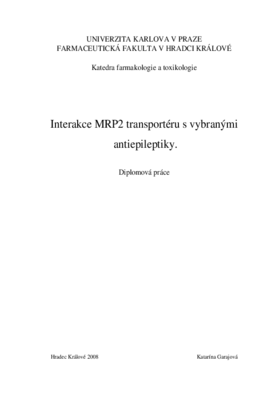Interakce MRP2 transportéru s vybranými antiepileptiky
Interactions of selected antiepileptic drugs with MRP2 transporter
diploma thesis (DEFENDED)

View/
Permanent link
http://hdl.handle.net/20.500.11956/16153Identifiers
Study Information System: 17950
Collections
- Kvalifikační práce [6729]
Author
Advisor
Referee
Červený, Lukáš
Faculty / Institute
Faculty of Pharmacy in Hradec Králové
Discipline
Pharmacy
Department
Department of Pharmacology and Toxicology
Date of defense
4. 6. 2008
Publisher
Univerzita Karlova, Farmaceutická fakulta v Hradci KrálovéLanguage
Czech
Grade
Excellent
Interakce MRP2 transportéru s vybranými antiepileptiky Epilepsie je časté neurologické onemocnění postihující přibližně 1-2% populace. U většiny epileptických pacientů jsou záchvaty účinně kontrolovány v současnosti dostupnými antiepileptiky (AED - anti-epileptic drugs). Uvádí se, že přibližně 30% pacientů nedochází k zastavení záchvatů, navzdory pečlivě optimalizované léčbě. Většina těchto pacientů s farmakorezistentní epilepsií neodpovídá na léčbu různými AED s různými mechanismy účinku, což naznačuje, že rezistence u epilepsie je multifaktoriálním fenoménem nezávislým od použitého léčiva. Na základě experimentálních a klinických studií byly předloženy dvě hlavní teorie vysvětlující vznik farmakorezistence. První z nich je hypotéza cílových struktur, která se zabývá změnami ve vlastnostech cílových struktur pro AED jako příčinami jejich snížené farmakosenzitivity. Druhou je transportérová hypotéza, která hovoří o zvýšené expresi efluxních multi-drug transportérů v mozku jako příčině snížení přístupu AED k cílovým strukturám. Největší a nejvýznamnější rodinou multidrug-transportérů exprimovaných v mozku a pravděpodobně odpovědných za snížení účinné koncentrace mnohých AED v mozkové tkáni je nadrodina ABC (ATP- binding cassete) transportérů. Jedním z transportérů této rodiny, kterým byla v současnosti...
Interaction of the MRP2 transporter with selected anti-epileptic drugs Epilepsy is a common neurological disorder affecting approximately 1-2% of the population. In most of the patiens with epilepsy, seizures are well-controlled with currently available anti-epileptic drugs (AEDs). It is estimated that 30% of the patients fail to achieve seizure termination despite carefully optimized drug treatment. Most of these patients with refractory epilepsy are resistant to several AEDs with different mechanisms of action, which suggests that resistance in epilepsy is a multifactorial and drug-nonspecific phenomenon. Based on experimental and clinical studies, two major theories have been put forward to explain the development of pharmacoresistance in epilepsy. The target hypothesis holds that changes in properties of drug targets for AEDs may result into their reduced drug sensitivity. The transporter hypothesis contends that the over-expression of efflux multidrug-transporters in the brain leads to impaired access of AEDs to their targets. The largest and the most important family of multidrug-transporters expressed in the brain, is the ABC (ATP-binding cassette) transporter family. One of the transporters in this family, recently under study, is the multidrug resistance-associated protein 2 (MRP2). The MRP2...
